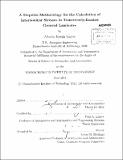| dc.contributor.advisor | Paul A. Lagace. | en_US |
| dc.contributor.author | Gayón, Alberto Joseph | en_US |
| dc.contributor.other | Massachusetts Institute of Technology. Dept. of Aeronautics and Astronautics. | en_US |
| dc.date.accessioned | 2011-11-18T20:57:18Z | |
| dc.date.available | 2011-11-18T20:57:18Z | |
| dc.date.copyright | 2011 | en_US |
| dc.date.issued | 2011 | en_US |
| dc.identifier.uri | http://hdl.handle.net/1721.1/67183 | |
| dc.description | Thesis (S.M.)--Massachusetts Institute of Technology, Dept. of Aeronautics and Astronautics, 2011. | en_US |
| dc.description | Cataloged from PDF version of thesis. | en_US |
| dc.description | Includes bibliographical references (p. 263-267). | en_US |
| dc.description.abstract | A stepwise methodology to assist in the development of a model to determine the interlaminar stress fields and the mechanisms that give rise to these stress fields in transversely-loaded grooved composite laminates was developed. The methodology consists of five steps, with each step representing a laminate configuration with an increase in complexity from the previous step. Models for each step were developed in the context of a general formulation proposed in the literature that was previously used to analyze the proposed problem for Step 1. This general formulation is based around an assumed stress approach, where unknown coefficents in the assumed stress shapes are solved via the Principle of Minimum Complementary Energy. Models derived from such an approach were designed to be both accurate in the results as well as more efficient in runtime as compared to other models (e.g. finite element models). Such models are particularly useful for preliminary design, where various laminate configurations need to be analyzed efficiently to find designs for more detailed analysis and further modification. The results from the models for Steps 1 through 3 were found to be in good agreement with results in the literature, when available, or finite element results when analyzing configurations with results not found in literature. Characteristic results were taken from the models for Steps 1 through 3 in order to determine modifications, as well as identifying phenomena in the stress distributions, that require particular attention in the formulation of subsequent models. Key controlling factors in the model for Steps 1 through 3 are identified from the results. Issues encountered in Step 4 with regard to representation of slanted dropoffs prevent further model development. The feasibility of the formulation of the Step 5 model, involving loaded edges, was established assuming a working Step 4 model. Modifications of Steps 4 and 5 of the initially-proposed stepwise methodology were developed such that models for the proposed problems can be developed using the general formulation established for previous steps. These modified steps allow for a closed-form solution within the context of the general formulation as well as identification of the mechanisms and laminate parameters that affect interlaminar stress fields in transversely-loaded grooved laminates. Recommendations for future work are made. | en_US |
| dc.description.statementofresponsibility | by Alberto Joseph Gayon. | en_US |
| dc.format.extent | 347 p. | en_US |
| dc.language.iso | eng | en_US |
| dc.publisher | Massachusetts Institute of Technology | en_US |
| dc.rights | M.I.T. theses are protected by
copyright. They may be viewed from this source for any purpose, but
reproduction or distribution in any format is prohibited without written
permission. See provided URL for inquiries about permission. | en_US |
| dc.rights.uri | http://dspace.mit.edu/handle/1721.1/7582 | en_US |
| dc.subject | Aeronautics and Astronautics. | en_US |
| dc.title | A stepwise methodology for the calculation of interlaminar stresses in transversely-loaded grooved laminates | en_US |
| dc.type | Thesis | en_US |
| dc.description.degree | S.M. | en_US |
| dc.contributor.department | Massachusetts Institute of Technology. Department of Aeronautics and Astronautics | |
| dc.identifier.oclc | 758499369 | en_US |
